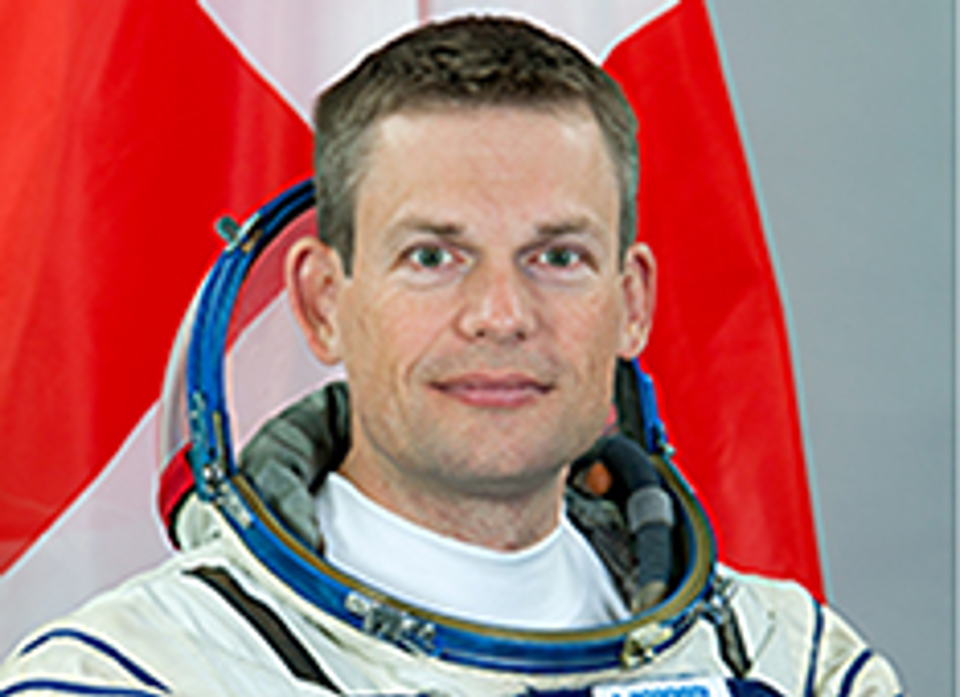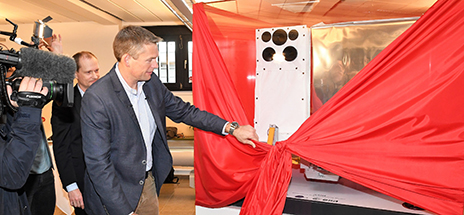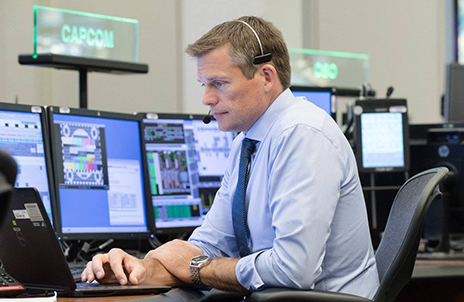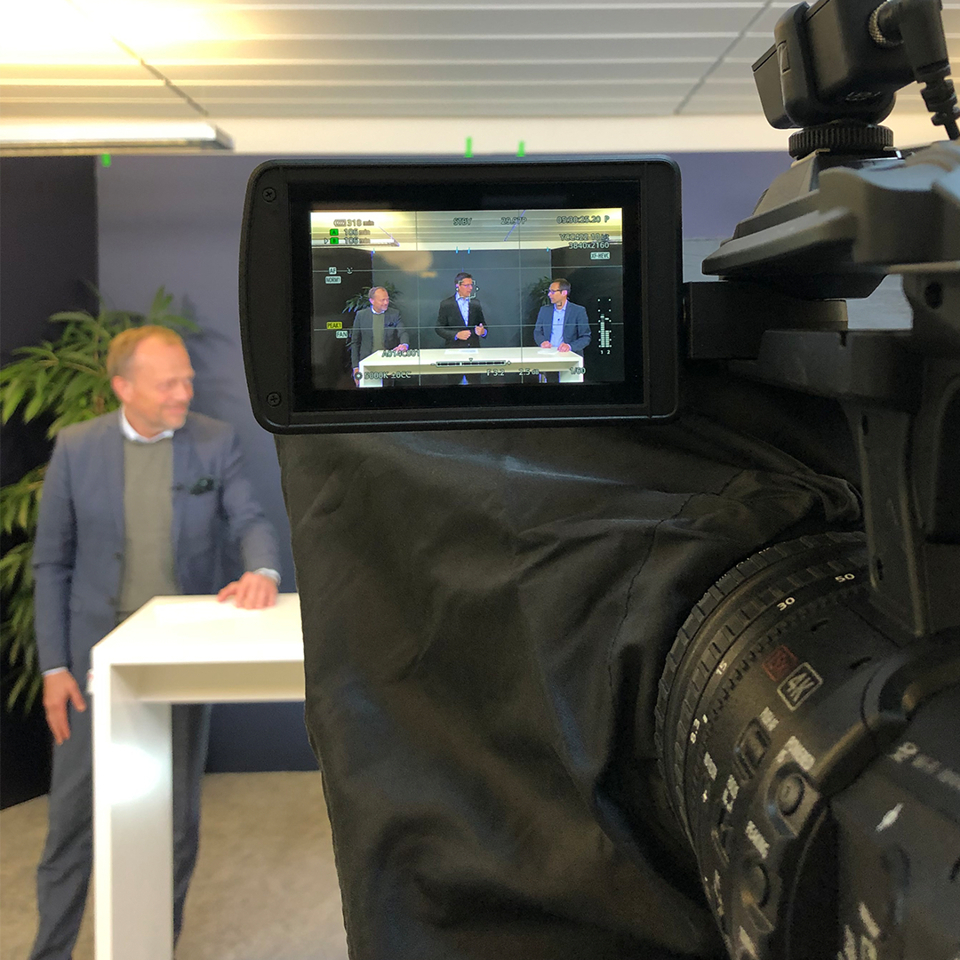2018-03-23
Lead CAPCOM Andreas Mogensen: “We practice faults and problems”
The countdown to the launch of Denmark's next large European space project, ASIM, has begun.

By Christina Tækker, DTU
On 2 April 2018, the ‘Atmosphere-Space Interactions Monitor’ (ASIM) observatory is scheduled for launch to the International Space Station (ISS) from Cape Canaveral in Florida. The Dragon spacecraft – carried by a SpaceX Falcon 9 two-stage rocket – will be used to transport ASIM to ISS.

Andreas Mogensen unveils ASIM model at Terma in Herlev, Denmark
ESA astronaut Andreas Mogensen – who is situated at NASA in Houston – participates in the ASIM mission as ‘lead CAPCOM’ (capsule communicator). His job is to communicate with the astronauts on the ISS during the three days it takes for the Dragon to catch up and dock at the ISS.
The Dragon spacecraft is positioned in the same orbit plane as the ISS, but at a lower altitude, which gives it a higher velocity. When it approaches the ISS, it will increase the altitude by turning on its rocket boosters in several stages to slow the velocity relative to the ISS. When Dragon has reached a location of 11 meters below the space station, the astronauts on the ISS will use the Canadarm-2 robotic arm to capture and dock Dragon to ISS. On the last day, the hatches between the space station and Dragon will be opened to allow access to ASIM and other cargo.
Simulations in the control center
“As lead CAPCOM for SpaceX-14, I follow the preparation and planning activities of the Dragon mission from the astronauts’ perspective. I also train rendezvous and docking with the flight control team here in Houston. The last two months before the launch, we perform six to seven simulations in the backup control center, where we practice how to handle all faults and problems that may occur during the mission,” says Andreas Mogensen.
The ASIM observatory, which will be mounted on the outside of the European Columbus module on ISS, will observe and photograph the powerful electrical discharges from thunderclouds that reach upwards into the stratosphere and mesosphere. Understanding these lightning phenomena – known as red sprites, blue jets, halos, and elves – will help to improve uncertainties in climate change models.
Important experience as an astronaut
“I expect us to obtain a lot of exciting data which can give us extensive new knowledge. Hopefully, ASIM will be up there for a long time,” explains Andreas Mogensen.
In his job as lead CAPCOM, he draws on his experience as an astronaut:
“Having been on board the space station means that I have a lot of important knowledge and experience that I can use in my job as CAPCOM. I’m familiar with the astronauts’ work and the challenges they face if something has to be repaired. The job as CAPCOM entails translating technical engineering jargon into a more operational language, which the astronauts can understand – for example, information about which tools they need to use, and what they should be particularly careful of. It’s more about the actions to be performed by the astronauts than about the composition of the system.”

CAPCOM Andreas Mogensen in the mission control center in Houston, Texas, USA
This is what Mogensen’s working day will look like:
04:00 GMT: The first shift begins with the arrival of Flight Director Andreas Mogensen and the rest of the ‘flight control’ team at the control center in Houston. At this point, the Dragon spacecraft will be around 3.5 km from the space station.
06:00 GMT: The astronauts onboard the space station get up.
08:30 GMT: The astronauts prepare the robotic arm.
09:00-11:00 GMT: The astronauts monitor the final approach of the Dragon spacecraft from approximately 1 km to the capture point around 11 m from the space station. If they notice something unexpected, they can send a command to the Dragon spacecraft to abort the approach and change course.
11:00 GMT: The astronauts capture the Dragon spacecraft with the robotic arm.
11:00-15:00 GMT: The robotic arm operator in the control center takes over control of the robotic arm and moves the Dragon spacecraft from capture point to the docking point on the underside of the Harmony module on ISS. During this operation, the astronauts eat lunch and work on their other tasks/research.
13:30 GMT: The next shift starts in the control center. Andreas Mogensen and the rest of the team on the first shift go home.
16:00-17:00 GMT: The astronauts pressurize the airlock between the space station and the Dragon spacecraft and test whether it is airtight.
17:00-18:30 GMT: The astronauts open the hatch on the Harmony module into the vestibule and dismantle equipment in the vestibule that was used during the docking.
The astronauts can choose to open the hatch to the Dragon spacecraft the same evening or wait until the next morning.
It will then probably take a couple of days before the ASIM payload is installed on the Columbus module on ISS. The robotic arm operator in the control center will probably install the ASIM without help from the astronauts. This is typically done while the astronauts are sleeping.
---
ASIM relies on experience from the research project THOR. DMI and Herzliya University in Israel investigated the possibilities of making forecast to enable Andreas Mogensen to take photos and videos of thunderstorms from space – which was successful. Senior researcher Martin Stendel from DMI will contribute to ASIM with scientific interpretation of data in the course of Denmark’s next large space project.
ASIM is developed under the auspices of the European Space Agency, ESA. DTU Space has the scientific leadership of the mission. The Danish aerospace company Terma A/S has the overall technical responsibility and the Danish Meteorological Institute supplies global meteorological data products and participates in the scientific studies. Additional partners are University of Valencia, Spain, University of Bergen, Norway, Space Research Center, Poland, OHB-Italia, Italy, and B.USOC, Belgium.
The Ministry of Higher Education and Science in Denmark has provided funds for the ASIM project. Some of the funding has been provided during the period 2009-2012 from the global funds for climate initiatives via the European Space Agency (ESA). Thereby, it has been possible to strengthen the excellent research, development, and implementation of Danish high technology and the collaboration between universities and the industry.

Who we are
Terma in Brief
The Denmark based high-tech Terma Group develops products and systems for defense and non-defense security applications; including command and control systems, radar systems, self-protection systems for aircraft, space technology, and aerostructures for the aircraft industry.
Learn more about us



